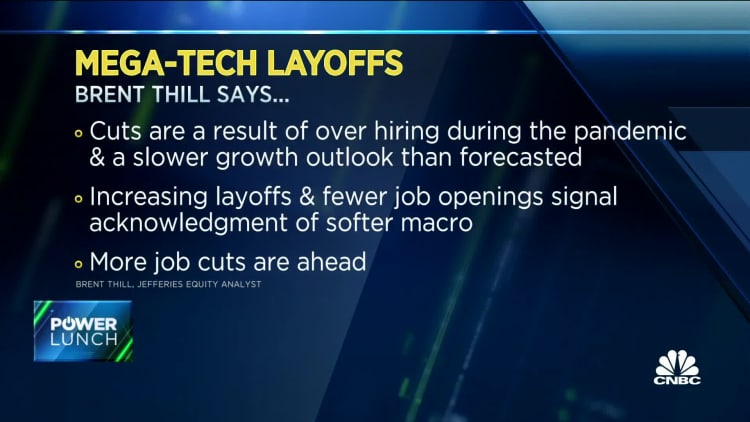
People take selfies in front of the logo of Facebook parent company Meta on November 9, 2022 in Menlo Park, California. Meta will lay off more than 11,000 staff, the company said on Wednesday.
Liu Guanguan | China News Service | Getty Images
The seemingly breathless pace of layoffs across the tech sector may seem staggering. In November alone, the 76,835 layoffs were nearly double from October.
But the total number, year to date, is the second lowest on record, according to a report by Challenger, Gray & Christmas which has been tracking job cuts since 1993.
“When we’re looking at layoffs across the board, while we have seen an uptick from the historic low layoff [numbers] we’ve [had] the last two years, we’re not seeing huge mass layoff activity,” senior vice president Andrew Challenger recently told CNBC.
At CNBC’s CFO Council Summit earlier this month in Washington, D.C., KPMG chief economist Diane Swonk waved off concerns about the recent layoffs when she said, “I’m not worried about those [tech] workers not getting jobs pretty quickly.”
With skilled workers still in demand, a growing question is where all this tech talent ultimately lands — and how long it takes. One sector making a play for it: the federal government.
Kurt DelBene, chief information officer at the U.S. Department of Veterans Affairs, says he’s on a mission to hire the designers, engineers, and cyber talent that have been laid off by Meta, Google, Twitter and other tech firms shedding workers in the face of their own slowing growth and a tougher economic climate.
DelBene spent 30 years at Microsoft, including a stint as president of its Office division, before joining the VA earlier this year. He’s hoping to capitalize on the availability of laid-off tech talent by positioning the VA as a place where engineers and software designers can “really sink their teeth into designing and redesigning new systems” to make the agency a digital-first organization.
He’s also planning to lean on the history and mission of the VA itself.
“It’s one thing to build productivity software for individuals,” DelBene said. “It’s quite another to think about how your systems deliver healthcare benefits to veterans who have so selflessly given of themselves to defend our country.”
Paying more and making hiring easier
Of course, this isn’t the first time that the public sector has tried to woo tech talent from private companies. For decades there’s been a shortage of IT talent across the government thanks to lower pay and onerous hiring and security hurdles.
DelBene said he’s navigating around these challenges. On the salary front, he’s working to close about 60% of the pay gap that exists between IT jobs in the private sector and the federal government by building a special salary rate for IT professionals. He’s confident it will be approved by the Office of Personnel Management early next year.
He’s also looking to streamline the hiring process so that offers to the right candidates can be made more quickly. The goal over the next year is to bring about 1,000 new IT professionals into the VA. “I think I’ll be able to hire every qualified person that comes our way that we have a role for,” he adds. “I’d love to get to a point where the only openings I have are from natural attrition.”
That’s a lofty goal — and one that comes with a lot of competition. Most of the jobs in the tech sector that have been cut involve skills that are highly transferable, said Simone Petrella, CEO of CyberVista, a cybersecurity training and development company. Whether it’s a pure or related set of tech skills such as those in HR, recruiting, or marketing, these workers are being sought out by companies in healthcare, retail, manufacturing and finance, she said.
“This is an opportunity for those industries, that have traditionally lagged behind in digital transformation and cybersecurity, to hire talent at a level they may not have been able to before when the tech industry was gobbling them up,” Petrella said.

